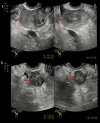Parasitic Leiomyoma at Laparoscopic Trocar Site: A Report of 2 Cases
- PMID: 39312504
- PMCID: PMC11426176
- DOI: 10.12659/AJCR.944951
Parasitic Leiomyoma at Laparoscopic Trocar Site: A Report of 2 Cases
Abstract
BACKGROUND Parasitic leiomyoma refers to leiomyomas outside the uterus, with a prevalence of 0.07%. Patients are initially asymptomatic and may later develop abdominal pain and abdominal distension. Parasitic leiomyomas at a trocar site are extremely rare and lack detailed reporting. Here, we report 2 cases of parasitic leiomyoma at trocar sites. CASE REPORT Case 1. The patient was a 47-year-old woman with parasitic leiomyomas at a left trocar site 4 years after laparoscopic total hysterectomy. After being diagnosed with 3 masses on the surface of the sigmoid colon and 2 in the pelvic cavity, the patient underwent laparoscopic removal of a pelvic lesion and 3 lesions on the surface of the colon, combined with excision of abdominal wall masses. The pathology result indicated that the masses at the left trocar site were multiple leiomyomas, the intestinal mass was multiple leiomyomas with abundant cells, and the pelvic mass was fibrous capsule parietal tissue. This patient received 3 months of gonadotropin-releasing hormone agonist (GnRH-a) treatment, and was followed up for 9 months without recurrence. Case 2. The patient was a 50-year-old woman with parasitic leiomyoma at the right trocar site 15 years after laparoscopic removal of the right ovarian cyst. At admission, she underwent transabdominal total hysterectomy, bilateral fallopian tube resection, and abdominal wall lesion resection. The pathology report showed multiple leiomyomas of the uterus, and the cell-rich parasitic leiomyoma at right trocar site with unclear boundary. She received 3 months of GnRH-a treatment, and was followed up for 6 months without recurrence. CONCLUSIONS For patients with a history of laparoscopy, gynecologists should be alert to the occurrence of parasitic leiomyoma.
Conflict of interest statement
Figures






Similar articles
-
Parasitic leiomyoma in the trocar site after laparoscopic myomectomy: A case report.World J Clin Cases. 2022 Mar 26;10(9):2895-2900. doi: 10.12998/wjcc.v10.i9.2895. World J Clin Cases. 2022. PMID: 35434089 Free PMC article.
-
Port site parasitic leiomyoma after laparoscopic myomectomy: a case report and review of the literature.J Med Case Rep. 2018 Nov 15;12(1):339. doi: 10.1186/s13256-018-1873-y. J Med Case Rep. 2018. PMID: 30428912 Free PMC article. Review.
-
Multiple leiomyomas after laparoscopic hysterectomy: report of two cases.J Minim Invasive Gynecol. 2007 Jan-Feb;14(1):123-7. doi: 10.1016/j.jmig.2006.08.002. J Minim Invasive Gynecol. 2007. PMID: 17218244
-
An Intraluminal Parasitic Leiomyoma of the Sigmoid Colon and Potential Pathogenetic Mechanisms.Cureus. 2021 Oct 3;13(10):e18451. doi: 10.7759/cureus.18451. eCollection 2021 Oct. Cureus. 2021. PMID: 34745776 Free PMC article.
-
Gigantic parasitic leiomyoma of 19 kg in a postmenopausal woman: A case report and review of the literature.J Obstet Gynaecol Res. 2021 Aug;47(8):2777-2781. doi: 10.1111/jog.14854. Epub 2021 May 20. J Obstet Gynaecol Res. 2021. PMID: 34018284 Review.
Cited by
-
AMH and Kisspeptin Receptor Expression in Rare Hydropic Leiomyoma: A Case Study.Am J Case Rep. 2025 Apr 30;26:e947953. doi: 10.12659/AJCR.947953. Am J Case Rep. 2025. PMID: 40305440 Free PMC article.
References
-
- Willson JR, Peale AR. Multiple peritoneal leiomyomas associated with a granulosa-cell tumor of the ovary. Am J Obstet Gynecol. 1952;64(1):204–8. - PubMed
-
- Taubert HD, Wissner SE, Haskins AL. Leiomyomatosis peritonealis disseminate – an unusual complication of genital leiomyomata. Obstet Gynecol. 1965;25:561–74. - PubMed
-
- Hlinecká K, Richtárová A, Lisá Z, Kužel D, Hanáček J. [Parasitic leiomyoma – a case report and review of the literature.] Ceska Gynekol. 2021;86(6):400–5. [in Czech] - PubMed
Publication types
MeSH terms
LinkOut - more resources
Full Text Sources

